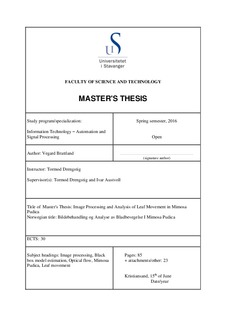| dc.contributor.advisor | Drengstid, Tormod | |
| dc.contributor.author | Brattland, Vegard | |
| dc.date.accessioned | 2016-10-10T11:50:25Z | |
| dc.date.available | 2016-10-10T11:50:25Z | |
| dc.date.issued | 2016-06 | |
| dc.identifier.uri | http://hdl.handle.net/11250/2413937 | |
| dc.description | Master's thesis in Cybernetics and signal processing | nb_NO |
| dc.description.abstract | This thesis has the aim of develop and improve methods used in an ongoing
research project at the University of Stavanger, where the plant mimosa pudi-
cas response to change in its illuminative conditions is being examined. The
intention is to use these methods to analyse the mimosa pudicas responses,
as well as exploring the possibility of relating them to a control theoretic
viewpoint.
An image processing routine, using the HSV color model and triangle intensity
threshold segmentation, was developed to segment time-lapse image
series of the Mimosa Pudica - quantifying the plants image pixel count as a
metric. The result was used to estimate the ARX, ARMAX and Box Jenkins
black box models, with the plants illuminative condition and image pixel
count being used as the systems input and output. A routine for a second
metric was also developed, using the method of Farneback to estimate dense
optical
ow, describing the plants movement orientation in the image plane.
The automatic non-parametric image segmentation routine performance
was evaluated on 7 test images, obtaining a DICE similarity coe cient of
0:932 0:0175. Several ARX, ARMAX and Box Jenkins models was estimated
without being able to capture the systems dynamics. The routine
describing mimosa pudicas movement orientation was during the experiment
found to give a seemingly correct description of a small time-lapse sequence.
The successfully development of a automatic non-parametric image segmentation
routine will remove the need of manual intervention. The observed
dynamics in the mimosa pudica indicates that the changes in the illuminative
condition could be working as a disturbance on the plant. The dense optical
ow experiments did also shown patterns of the mimosa pudica starting its
response to the shift in the illuminative condition, before the actual shift
occurred. This suggests that a complex structure could lie behind the plants
response to the illumination regimes. | nb_NO |
| dc.language.iso | eng | nb_NO |
| dc.publisher | University of Stavanger, Norway | nb_NO |
| dc.relation.ispartofseries | Masteroppgave/UIS-TN-IDE/2016; | |
| dc.subject | informasjonsteknologi | nb_NO |
| dc.subject | signalbehandling | nb_NO |
| dc.subject | automatisering | nb_NO |
| dc.subject | image processing | nb_NO |
| dc.subject | black box model estimation | nb_NO |
| dc.subject | optical flow | nb_NO |
| dc.subject | mimosa pudica | nb_NO |
| dc.subject | leaf movement | nb_NO |
| dc.title | Image Processing and Analysis of Leaf Movement in Mimosa Pudica | nb_NO |
| dc.type | Master thesis | nb_NO |
| dc.subject.nsi | VDP::Technology: 500::Information and communication technology: 550::Technical cybernetics: 553 | nb_NO |
